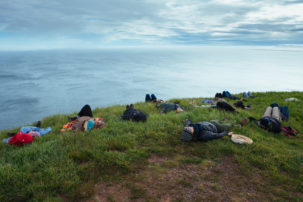In the Spring 2019 issue, we bring together some inspiring voices that defy political boundaries—diverse, but united with a deep and shining love for their roots. We bring forward some of our most pressing questions and concerns from our perspective as a pair of Inuuk from the diaspora. Throughout, our main purpose is clear: to make space for Inuit and other circumpolar Indigenous artists.
The following principles helped us narrow our focus through all the beauty of the circumpolar world and its artists: the cyclic and immemorial nature of time; past and future kin; releasing binary-based thinking in all regards; the importance of community; and our transcendent relationship to the cosmos. We found inspiration in the work of the Isuma collective, and celebrate their selection to represent Canada at its pavilion for the 2019 Venice Biennale. The community-based, forward-looking, high-tech work of Isuma is foundational. Isuma has pushed through and beyond the forced aesthetics expected of Inuit art, unsettling the line between traditional and contemporary. In a similar battle, we question the boundaries of North and South (what do these terms even mean?), seeking ways that one may be Inuk outside their homelands. Time and time again, boundaries are forced upon us. Our work is to dispel them.
At the outset, we asked our contributors how they connect to their ancestors through Space and Time. The question is answered in some interesting ways across these pages. With each contribution, we noticed the writers continually brought forward the importance of voice. This prompted us to question, Who is not being heard? It is at the top of our minds, through our practice together, to find ways to include and support our sexually and gender-diverse friends, family and artists—beloved people who often find that our communities are a smothering environment for their (our) flame. A courageous and strong group of sexually and gender-diverse Inuit are emerging, and we hold space for these voices. Here Inupiaq photographer Jenny Irene Miller discusses her work Continuous with us, a photographic project that shares the stories of resilient people in her community. Miller’s work gives voice to its subjects. In finding and using our voices, we find power.
Great effort is put into trying to listen for the voices and the wisdom of those who passed many years ago. It’s not an easy task, especially when their thoughts have been interpreted in the pages of books written by European ethnographers. Studious and so fiercely nerdy, artist and tattooist Maya Sialuk Jacobsen employs a practice of reading between the lines. She works diligently, attempting to pull away the layers of prejudice and judgment that fog up the words of the ancestors as their movements were charted. While we find ways to connect to our history with patterns of ink, which leave traces and trails all over our skin, it’s vital we remember that it’s not only in making the mark that we can find meaning. Each pattern has meanings that can be rekindled when we take the time to listen to our Elders and Ancestors. Before doing, we must listen.
Katajjaq is a pastime that requires intense active listening and interacting, one that explores the terrain between speaking/listening, watching/acting, learning/doing. This musical game of call-and-response is now so special to Inuit. But 50 years ago this art form was nearly wiped out of practice. The communities of Puvirnituq, and Nunavik’s cultural institute Avataq, did great work to bring katajjaq out of the shameful shadow it had been shoved into. This piece of intangible cultural heritage is carried forward by many voices today. Tiffany Ayalik, an Inuk throat singer, and Niillas Holmberg, a Sámi yoiker, exchange their knowledge of these resurgences. This issue has been a wonderful opportunity to combine Inuit and other Indigenous perspectives from across Inuit homelands and the many other places we find ourselves. It is very special to share space with our Sámi cousins, who are completely different from us, but also kind of the same.
Variations of Inuit stories that take place at the beginning of time illustrate that our words are so powerful that we could speak things into existence. It is humbling to have this opportunity to connect and create with the wonderful humans involved with this SPACETIME issue.
Thank you, kind reader, for taking the time to listen. Thank you to the lands the contributors live on, that sustain them and make their work possible. Nakurmiik to all the families and friends who give their support. Quyanainni to the Dish with One Spoon, home of the Wendat, Haudenosaunee, Anishinaabe and Mississaugas of the New Credit, on whose lands this publication is created. Nakurmiik, quyanainni to the whole team at Canadian Art for giving us a space to host all of these powerful humans. This is an incredible chance to contribute to the national dialogue on art.
For anyone who needs a friendly reminder: check in with one another. In this issue, and every day, we remember that we are here for just a simple moment, but together we make the best of these moments.








